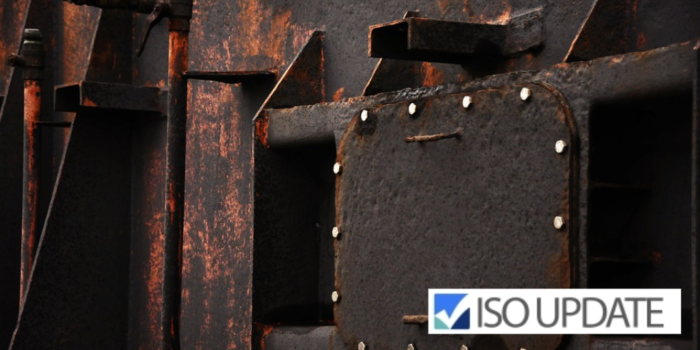ISO 8501: Corrosion Protection of Steel Structures by Painting
The overall quality, as well as durability, of paint coatings are affected by the condition of the substrate they are applied on. This is especially concerning when dealing with steel. The surface itself needs to be prepared thoroughly beforehand and, in the case of steel which commonly faces issues pertaining to corrosion and rusting, the surface preparation varies depending upon the different grades of rust, the type of paint selected, the exposure of the finished product and possible environmental concerns.
Some widespread methods of surface preparation (used before or even without coating) are dry blast cleaning, power tool or hand cleaning, degreasing, and water jetting. All these treatments have individual pros and cons and need to be carefully selected after a suitable assessment on the existing condition of the steel substrate they will be used on.
Some notable factors to consider would be rust and mill grades, the profile and presence of contaminants such as oil, water, dust and grease. The process of identifying different rust grades and the subsequent preparation can be quite arduous and, therefore, the ISO 8501 standard was created to act as a guide throughout the process.
What is ISO 8501?
ISO 8501 was published in 1988 as a combination of manual content from other standards like the Swedish Standard SIS 055900 and the German DIN 55928. ISO 8501 is meant to be a pictorial guide to different rust grades at various levels of cleanliness and contains supplementary descriptions via text as well. It’s a method of making visual assessments on the rust grades of the cleanliness of steel surfaces and helps determine paint coats and systems to be used on the substrate. It also ranks the processes of cleaning in order of increasing work required:
- Light Blast Cleaning
- Thorough Blast Cleaning
- Blast Cleaning to Visually Clean Steel
What does it consist of?
The standard is divided into 4 parts:
ISO 8501-1 – Includes different rust grades and the preparation of both uncoated steel substrates and steel substrates after overall removal of previous coatings.
This section of ISO 8501 identifies 4 different rust grades most commonly found on uncoated steel surfaces or on stored steel surfaces.
Specifically, the descriptions of rust refer to these 4 types (note that mill scale refers to a flaky blueish surface on hot rolled steel surfaces meant to protect against corrosion):
- A steel surface mostly covered with the adhering mill scale with little rust if any at all. (possible slight cracks within the mill scale
- A steel surface which has already begun to rust slightly, mostly the adhering mill scale has begun to flake or shows large cracks which enabled the corrosion.
- A steel surface on which the adhering mill scale has largely rusted away from or it can be scraped (is severely weakened), but with slight pitting visible under normal vision. (pitting is a localized symptom of corrosion where holes start appearing on metal surfaces)
- A steel surface on which the mill scale has almost entirely rusted away and on which general pitting is very obviously visible in normal vision.
ISO 8501-1 also identifies different cleanliness grades/ preparation grades for comparison purposes after you have completed preparing your uncoated surface or removed previous coatings from a surface.
Three preparation grades are identified and related to the cleaning method possibly used which is either:
- Blast Cleaning- Light, thorough/very thorough blast cleaning, or cleaning until visually clean steel.
- Hand and Power Tool Cleaning
- Flame Cleaning (rarely used)
ISO 8501-2 – Focuses on steel substrates after the localized removal of their previous paint coatings and their possible preparation processes and grades.
This portion of the standard is based upon the prior experience that dictates that the complete removal of previous paint coatings is not always necessary, practical or economical. This holds true especially when regular maintenance is already being carried out and efforts need to be focused on specific portions exposed to a certain pollutant of rust stimulant.
ISO 8501-3 – Deals specifically with surface ‘imperfections’ such as edges, welds etc. and the preparation grades for them
ISO 8501-4 – Deals with pre-project surface conditions, and relevant preparation grades and flash rust grades for high-pressure water jetting.
To summarize, ISO 8501 proves to be a detailed and helpful guide to identifying various rust grades through different levels of cleanliness of steel substrates.
For a more in-depth look into ISO 8501, read TQC Sheen’s PDF on the standard and its history.
ISO Terms Explained

To the novice quality manager, ISO jargon can be extremely overwhelming. What is an NCR? What do you mean by OFI? Are we certified or accredited? But before you go and pull out your hair, let’s take a moment to go over some of the most frequently used terms and their definitions with regards to ISO and Management System Certification.


